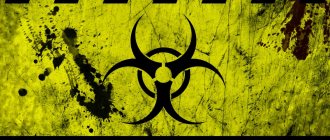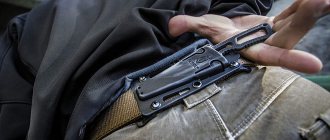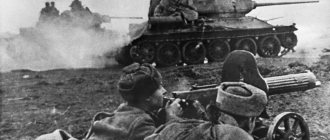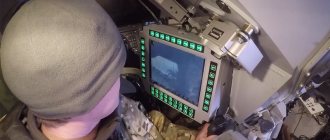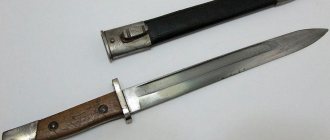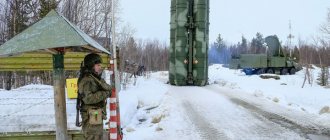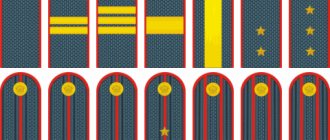Camouflage (from the French masque - to make unnoticed, invisible to anyone), a type of support for combat operations and the daily activities of troops; a set of measures aimed at misleading the enemy regarding the presence and location of troops (naval forces), various military installations, their condition, combat readiness and actions, as well as command plans. Camouflage helps to achieve surprise in the actions of troops, maintain their combat readiness and increase the survivability of objects. Based on the scale of application and the nature of the tasks being solved, camouflage is divided into strategic, operational and tactical. Depending on the reconnaissance assets against which camouflage measures are carried out, camouflage is distinguished between optical, thermal, radar, radio and electronic, sound (acoustic), hydroacoustic, etc.
Classification of camouflage actions by scale of application
Strategic camouflage is carried out by decision of the Supreme High Command and includes a set of measures to keep secret the preparation of strategic operations, campaigns, as well as to disorient the enemy regarding the true intentions and actions of the armed forces.
Operational camouflage is carried out by decision of the commander of the front forces (army), fleet (flotilla) and is aimed at ensuring the secrecy of the preparation of operations.
Tactical camouflage is carried out in formations, units, subunits and at individual objects in order to hide the preparation of a battle or the presence (location) of objects.
The success of camouflage is achieved by the allocation of sufficient forces and means and the compliance of camouflage measures with the tasks of the troops, their credibility and continuity, constant monitoring of the quality of their implementation and timely execution.
Deforming masks
(Article: Deforming masks)
Distorting (deforming) masks are used to change the shape of masked objects and their shadows.
Distorting masks include visors (horizontally or obliquely located flat panels), ridges (vertically positioned flat panels), extensions and superstructures (models of individual parts of the structure).
Deforming masks
Classification depending on the means of influencing the enemy
Optical camouflage counters photography, television and visual surveillance (including with the help of electro-optical devices). It is achieved by using the camouflage properties of the terrain, conditions of limited visibility, masks made from service and local materials, camouflage means for personnel, camouflage painting of equipment and structures, and compliance with light camouflage. To mislead the enemy, mock-ups of equipment, false structures and other means of imitation are used.
Thermal camouflage counteracts the detection of troops by means of thermal reconnaissance and the destruction of objects by shells with thermal homing heads; it is achieved by using the hiding properties of the terrain, shielding the heated surfaces of combat (special) vehicles and other objects with barriers opaque to infrared radiation, and the use of false thermal targets.
Radar camouflage eliminates, reduces, or distorts intelligence information obtained from radar stations. Its main activities are the location of troops (objects) in forests (groves), in small settlements, in fields of invisibility; interference; use of radar masks; use of corner reflectors to create false objects (targets).
Radio-technical camouflage is carried out against radio-technical reconnaissance equipment conducting direction finding of radar stations, operating radio stations and eavesdropping on radio communications; it is achieved by limiting or prohibiting the operation of radio and radio-electronic equipment, reducing the emission power of radio stations, using short signals, high-speed equipment, transmitting false radiograms (signals) and other means.
3-sound camouflage counteracts eavesdropping and reconnaissance by enemy sound-measuring stations and is carried out by reducing the noise of machines (mechanisms), muffling sounds (noises) with powerful sound curtains, reproducing the sounds of shots, movement (noises) of equipment by sound broadcasting stations and other methods.
Hydroacoustic camouflage is aimed against enemy acoustic means of surveillance of submarines. It is achieved by using soundproofing and sound-absorbing devices, using low-noise travel speeds, sheltering submarines under a jump layer (a layer of water below which sonars do not detect the boat), turning off highly noisy auxiliary mechanisms, using self-propelled and non-self-propelled (firing) devices and cartridges that imitate acoustic the presence of a submarine and diverting enemy search ships and aircraft (helicopters) to false directions.
Methods of masking
Methods of camouflage are: concealment, demonstrative actions, imitation and disinformation.
Concealment consists of eliminating or weakening the unmasking signs of troops (military objects) and their actions (activities). This is ensured by keeping command plans secret, by troops using the camouflage properties of the terrain, natural shelters, conditions of limited visibility, by using technical means of camouflage, by observing camouflage discipline, and by dispersing troops.
Demonstrative actions are a deliberate demonstration by real units (units) of the movement of troops (forces), the concentration of groups, the conduct of combat and other actions with the task of creating a false impression among the enemy about the intentions of the command in battle (operation). Imitation consists of constructing false positions in troop deployment areas and other false objects using engineering, radio-electronic, smoke and other technical means.
Disinformation is achieved by disseminating false information using technical means of communication through the press, radio broadcasting, and television.
Masking is organized by commanders (commanders and staffs). Camouflage tasks are determined on the basis of the plan for the upcoming combat operations and the instructions of the senior commander. When organizing camouflage, the enemy's reconnaissance capabilities, the camouflage properties of the terrain, weather conditions, the capabilities of friendly troops and other conditions are taken into account. Concealing their location (their actions) is carried out by units (units) of all branches of the military in any situation without special instructions from higher command. Demonstrative actions, imitation and disinformation are carried out with the permission or on the instructions of the senior commander (commander).
Oblique masks
(Article: Slanted masks)
Inclined masks are attached to the ground with the bottom edge and are located at an angle of 30-60 degrees to it. Inclined masks are used to hide equipment in parking lots, field warehouses, as well as to eliminate falling shadows when camouflaging large stationary objects not only from ground, but also from air surveillance.
By the house By the tree By the ravine
Position of inclined masks
Stages of camouflage development
Means and techniques of camouflage depend on the methods of armed struggle, the military equipment used and are determined primarily by the capabilities of reconnaissance and destruction of the enemy. Before the advent of firearms, camouflage had no independent significance and, as a rule, came down to the use of the hiding properties of the terrain and conditions of limited visibility for the covert movement of troops (forces) and a surprise attack. With the advent of rifled firearms, the distances to detect and defeat the enemy became almost the same. This forced the troops to hide from enemy observation and fire, using not only natural masks, but also special means.
During the First World War, the warring parties began to widely use optical observation devices, photography, and optical sights; Aerial reconnaissance developed, including visual observation and aerial photography, as well as radio reconnaissance and hydroacoustic reconnaissance. All this led to the need to carefully hide troops (forces) and rear facilities. In the armies (navies) of a number of countries, camouflage units began to be formed, manuals and manuals were published; The supply of troops with special materials for carrying out camouflage measures was organized. And by the end of the war, camouflage turned into one of the types of support for combat operations.
Camouflage was also widely used during the Second World War. Concepts and plans for camouflage on a strategic scale began to be considered by the leadership and general staffs of the armed forces of states; operational camouflage became an integral part of supporting all major operations, having a serious impact on their success. Tactical camouflage has found wide application in all types of combat operations of troops (forces). Both in support of operations and on a tactical scale, a comprehensive use of all means and methods of camouflage was carried out, coordinated in terms of goals, time and place. Of great importance in the defeat of German troops during the counter-offensives of the Russian Army near Moscow and Stalingrad was a carefully thought-out and successfully carried out system of measures to camouflage troops and keep the preparation of these operations secret. Carrying out demonstrative actions and simulations, combined with careful concealment of the main groupings of troops and the organization of targeted disinformation of the enemy, ensured the surprise of attacks in many offensive operations of the Russian Army (Belarusian 1944, Lvov-Sandomierz 1944, Iasi-Chisinau 1944, etc.).
Camouflage measures played a significant role in the actions of other armies that participated in the 2nd World War. They were most fully and successfully carried out during the landing of American-British troops in Normandy (1944). On a large scale, camouflage of large rear targets located in the area of enemy aviation was carried out; measures were taken to hide real landmarks and create false landmarks.
In the post-war years, with the advent of new reconnaissance means, the role of camouflage increased. The official manuals of the armies of NATO countries emphasize that camouflage activities must be continuous and believable. To hide troops and objects, means of camouflage for personnel, service kits, dummy masks, smoke emission means, and local camouflage materials are used; protective, imitating and deforming coloring and other means and techniques; During their construction, ground-based structures are given a camouflage form in advance. When equipping decoy areas where troops are located, mock-ups of military and special equipment are used, as well as means of “revitalizing” decoy objects.
Trenches with shelter for armored personnel carriers and MTLBs and requirements for their construction
(Article: 1. Trenches with shelter for armored personnel carriers and MTLB and requirements for their construction)
Trenches for armored personnel carriers and MTLB create better conditions for performing fire missions and increase the protection of crews and equipment from the effects of destructive weapons. They are arranged with a circular or limited sector of fire.
A trench with a limited sector of fire has higher protective properties and provides better concealment of military equipment than a trench with all-round fire.
When constructing trenches in soft soils, rutted coverings made of logs, poles, fascines or brushwood are laid on the bottom of the ramp and pit. The bottom of the trench is sloped towards the ramp to ensure the flow of surface water into the drainage well.
Trenches for armored personnel carriers and MTLBs are dug out manually or using earthmoving machines.
Trench for armored personnel carriers and MTLB with a limited field of fire: a - with shelter for personnel; b – without shelter for personnel; 1 – drainage well; 2 – closed gap
In the firing sector, the parapet is 30 cm high, and along the side walls of the pit - 60 cm high. To protect the crews, covered gaps (dugouts) are installed in the trenches. Volume of excavated soil: 48 m3. Setting up a trench (without a gap) with a sapper shovel requires 65 man-hours or 0.6 PZM-2 machine-hours and 12 man-hours. A trench with a limited firing sector consists of a pit, a ramp and a parapet.
Camouflage means
Camouflage means - property, equipment, ammunition and products, both service and military-made, used to camouflage military installations. Depending on their purpose, they are divided into optical camouflage, radar camouflage, light camouflage, thermal camouflage, sound camouflage, hydroacoustic camouflage, smoke agents, pyrotechnic compositions, and camouflage paint products.
Optical camouflage means include: camouflage clothing; kits and masks; layouts and their sets. Camouflage clothing - overalls, suits, capes, robes - is used by reconnaissance officers, snipers, sappers, and signalmen operating in close proximity to the enemy. Summer camouflage clothing is usually multi-colored and spotted, winter clothing is white. Camouflage kits and masks (service masks) are designed to hide military equipment, vehicles, trenches and shelters. Their basis is a camouflage covering made of mesh cotton or synthetic fabric, nets with ribbons and pieces of fabric (film) attached to them in 3-4 colors (for spotted backgrounds) or one color (for desert and snow), as well as racks, guy ropes and others devices. Military-made masks are made from consumables (camouflage and other nets, PVC film, camouflage paper, various fabrics, burlap, ropes, wire, plywood, matting, etc.) and local ones (poles, brushwood, branches, grass, soil, snow, etc. .) materials. Layouts (sets of mockups) are designed to imitate weapons, military equipment, structures and local objects when creating false objects. Time sheet models are pneumatic or frame prefabricated structures for reusable use. Simplified layouts are also used to simulate camouflaged equipment (frameworks covered with camouflage coatings). Mockup kits allow you to simulate entire departments or individual objects.
Means of radar camouflage - radar reflectors (corner, dipole, etc.), radio-scattering and radio-absorbing coatings. Corner reflectors are structures made of metal (metalized) planes that reflect electromagnetic energy. They serve to interfere with enemy radars and imitate various equipment, structures, and local objects (landmarks). The reflectors used have different sizes and edge shapes (square, triangular, sector). Dipole reflectors (dipoles) are thin electrically conductive threads (ribbons) with a length equal to half the wavelength of the enemy radar radiation. They are used to create passive interference when camouflaging aircraft (helicopters) in the air and ships at sea.
Light camouflage means - blackout devices for headlights, side and signal lights of vehicles and armored vehicles, lighting kits, lamps and lanterns with camouflage attachments for general and local lighting; illuminated signs and indicators to indicate paths, crossings, passages, etc.; blackout curtains, shutters, shields. When simulating light unmasking signs, lighting means and military-made imitation light kits are usually used.
Thermal masking means are usually the following:
- devices that reduce the temperature of heated surfaces (at stationary objects - expansion chambers, devices for cooling combustion products by blowing air, spraying with water, etc., and on military equipment - heat-insulating devices made of asbestos, fiberglass, etc.);
- heat shields made of metal, heat-insulating materials, films and other non-combustible materials;
- special paint coatings with low thermal radiation coefficient;
- false thermal targets are devices that imitate the heated elements of real objects.
Sound camouflage means - sound broadcasting installations for hiding sound unmasking signs of troop movements and engineering work, as well as for reproducing noises simulating the activity of troops (engine operation, movement of military equipment, etc.). These also include various military-made devices to reduce the intensity of sounds (silencers, sound filters, etc.).
Means of hydroacoustic camouflage of modern submarines - an anti-hydrolocation coating on the boat's hull, which absorbs part of the energy emitted by the enemy's sonar; simulation devices released from a submarine, reproducing its hydroacoustic field or creating a cloud of gas bubbles, reflecting from which ultrasonic waves emitted by a sonar create an “echo”, like from a submarine.
Smoke camouflage means - devices and ammunition for creating smoke screens (smoke bombs; smoke equipment of ships; artillery smoke shells, mines, hand and rifle grenades; smoke machines and devices mounted on military equipment; aviation smoke bombs and pouring devices). They are used to blind the enemy, hide friendly troops, ships and their actions, and indicate the activities of false objects.
Pyrotechnic means of camouflage - compositions and products for reproducing light, sound and smoke signs of shooting, explosions, fires, area lighting, etc. on false objects. For this purpose, special pyrotechnic cartridges and bombs (simulators of shots, explosions), explosives, flammable materials are used , lighting and signal flares.
The means of camouflage painting include mechanisms, devices and tools for preparing, applying paints and preparing surfaces for painting (painting stations, various paint sprayers, brushes, brushes, color-picking devices, containers, etc.). Units and tools for painting work taken from the national economy can be used. For camouflage painting, ready-made oil paints and enamels, dry mineral paints with fixatives (oil-based, resinous, water-based or bitumen-based) and solvents, and local materials (soils, crushed slag, coal, brick, etc.) are used. Camouflage painting agents are used for protective, simulating and deforming painting of military equipment, fortifications and other structures.
